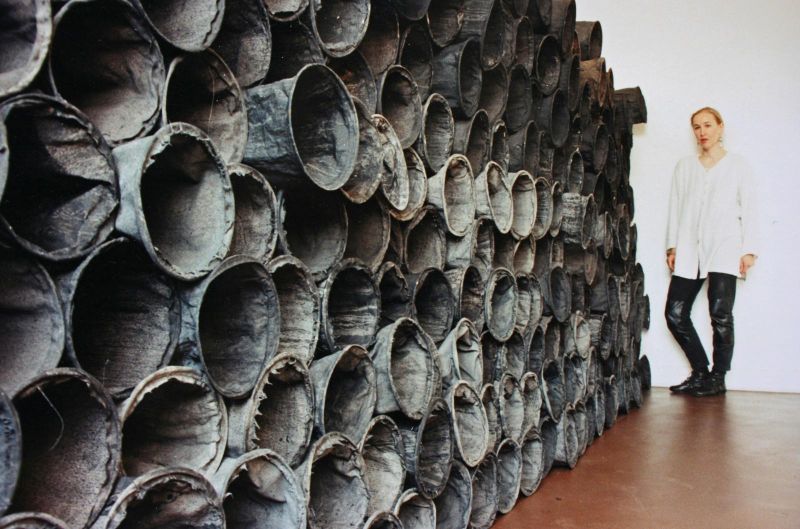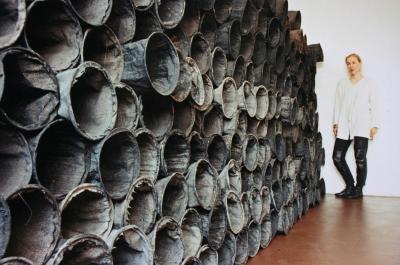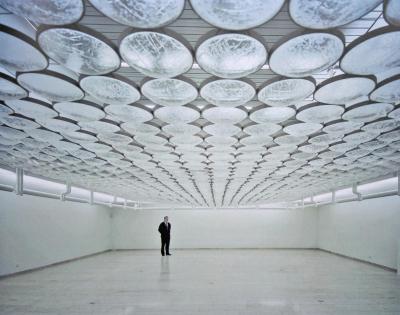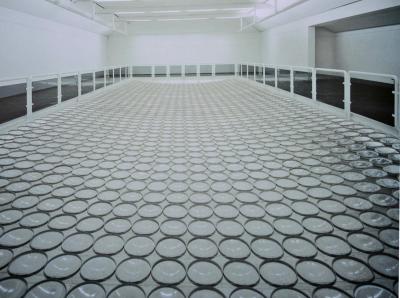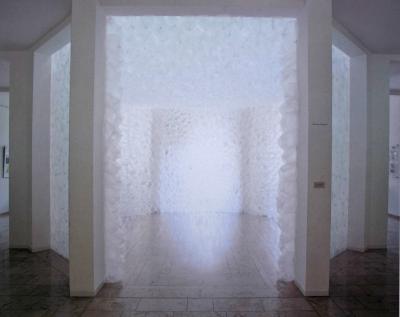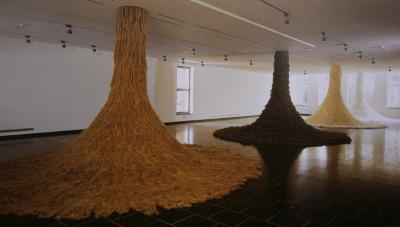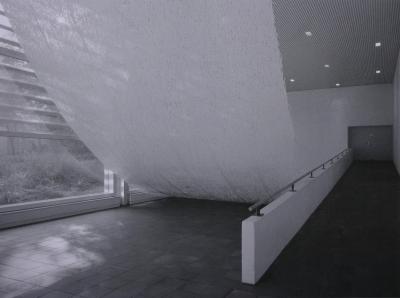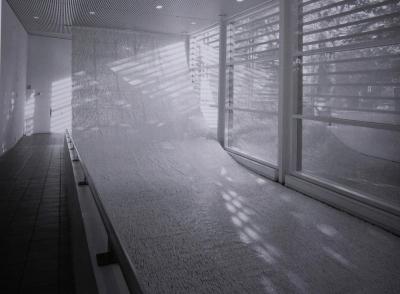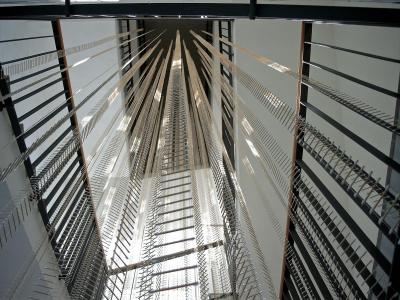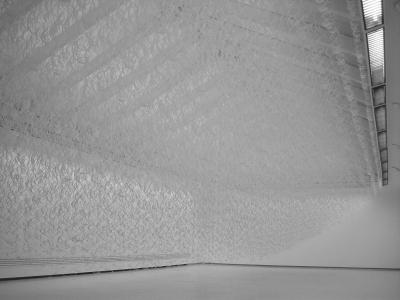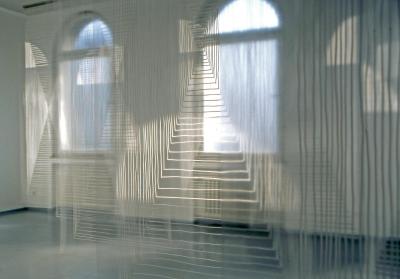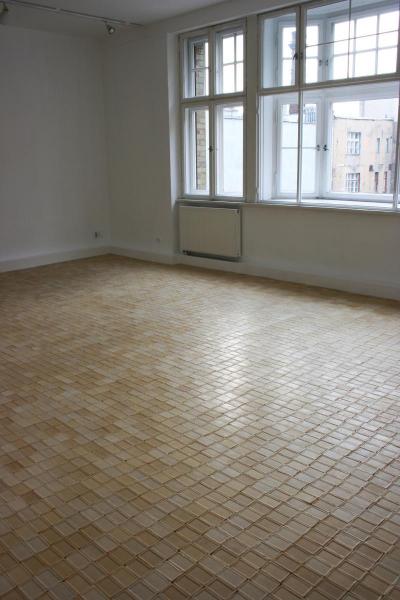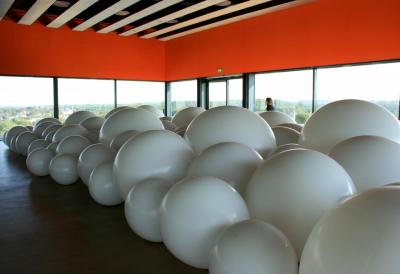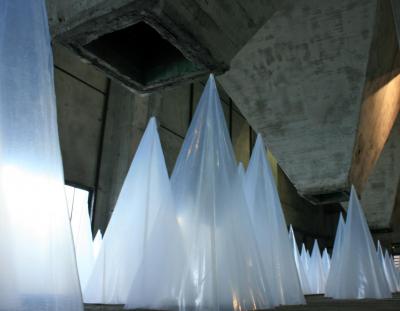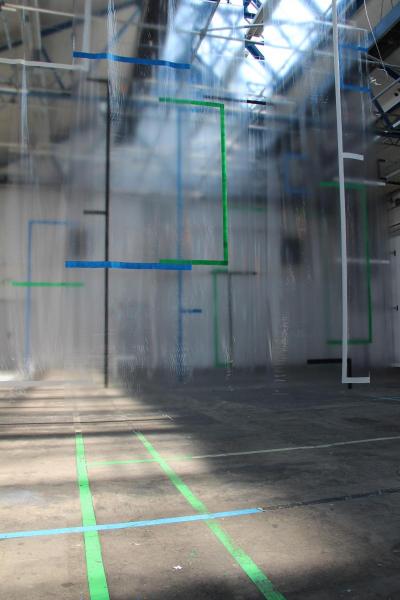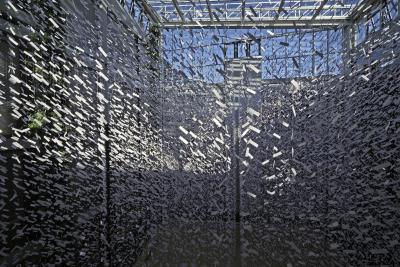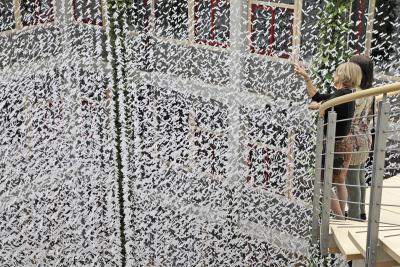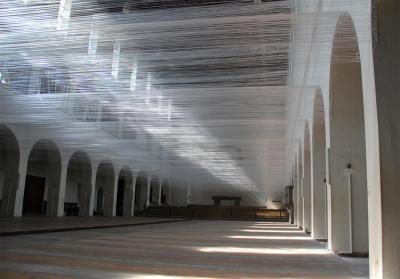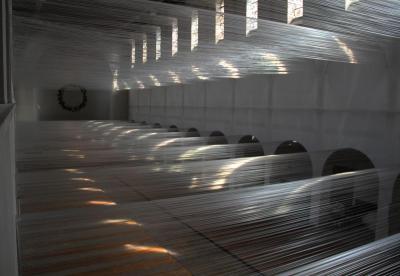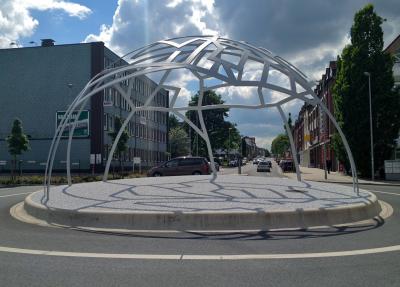Danuta Karsten – “In my work space is materialised”
Mediathek Sorted

In 1996 the artist created a three-storey metal object for the St.-Johannes church in Recklinghausen, in which she hung lenses made of water glass - a glass-like material that begins to flow invisibly under the influence of humidity. In 1998 she used a similar module (a hand-cast water glass lens in a cardboard ring) for an exhibition in the Ostdeutsche Galerie Museum in Regensburg; here she hung together around 1400 lenses to create an intermediate ceiling in the museum’s two-storey graphic hall. By doing so she redefined the original space so that the visitors could have differing visual experience from both stories (ill. 2 a, b). In the Galerie Koło in Danzig she then allowed the water glass material to flow under the influence of natural humility from a height of two metres all the way down to the ground. Time is a fundamental part of her installations. For the artist needs weeks and sometimes months to analyse the space and prepare the final work which can often consist of thousands of modules. For her installation in an exhibition entitled “Paper Moves“ in 2012 in Reutlingen she cut 66,000 tiny sheets of paper by hand (ill. 13). The material needs time in order to move in a certain form. Viewers need a certain period of time in order to truly grasp the spatial happenings from different perspectives and points of view. They have to “bring their own time into the dialogue in order to consider what they have seen and experienced”.
Another equally remarkable feature of her installations is their powerful graphic element that can be traced back to one of her earlier concerns: “the wish to draw within the space”. This has been confirmed by many commentaries on her work. One such drawing within a space was installed in the Museum Bochum in 2001: a 120 square metre curved area of paper made of thin glued strips (ill. 5 a, b). This characteristic is equally applicable to another installation in the Museum where paper garlands hung down from the ceiling; and to the “Paper Space” shown in Otterndorf in 2005, which consisted of 4000 hand-cut paper spirals (ill. 7). The graphic effect from every perspective applies all the more to her installation consisting of 60,000 matches, which she hung in the ten-metre high hallway of the Kunstverein in Ahaus (ill. 6).
Danuta Karsten’s work also contains “an intensive relationship to the free line”, where she works with taut ribbons. Two good examples of this were her outside installation above a circular flowerbed in front of Borbeck Mansion in Essen in 2006 (ill. 8 b), and her installation consisting of “100 kilometres” of synthetic strips in the Kunstkirche Christ-König in Bochum, which has the overwhelming effect of being a line drawing (ill. 14). But she can also create drawings in space when she inserts geometric figures drawn with paint sticks (ill. 8 a) or acrylic paint on hanging plastic sheets to create installations between which visitors can stroll. In doing so the black, white, blue and green lines of the installation in the Flottmann-Hallen in Herne in 2012 mirror the remains of the former line markings in the floor of the building (ill. 12) and transfer them once more into the space. Karsten’s “municipal dome” in a roundabout in Herten in 2013 can also be described as a network of lines, in that the idea came from a street map of the old town centre (ill. 15).
Light and movement are the main features of her installations. It is not only the white transparent materials but also the large amount of modules and their spatial distribution that give the impression of light refraction. Movement is primarily created by the slightest breath of air between the hanging or braced installations. This is also true of smaller scale works like the walls covered in bubble wrap in the foyer of the museum in Regensburg in 1999 (ill. 3), which continually changed according to the change of light and draught caused when the outside door was opened. Light and movement are particularly constituent features of her large-scale works like that in the Atrium of the Domino House in Reutlingen in 2012; this consisted of small paper cards hanging from 1,406 nylon strings (ill. 13): it was variously described as a “gigantic cloud” and as “an experience of indescribable multiplicity dependent on the daylight, the position of the sun or the artificial nocturnal light”, and triggered off associations with gigantic swarms, ice crystals and snowflakes. In 1913 visitors to the Kunstkirche Christ-König in Bochum (ill. 14) were “witnesses to a unique natural drama […] when the sunlight passed across the installation to […] conjure up optical sensations”. Her floor installation consisting of blocks of soap (ill. 9), first shown in 2007 in the Galerie Łaznia in Danzig and inspired by the building’s original function as a bath house, additionally stimulated visitors’ olfactory senses.
Art historical back references inevitably come to mind with the vibrating objects on the surface of works by Karsten’s academy teacher Günther Uecker; with the light and kinetic effects in the works of the “Zero” group (Uecker joined the group in 1961); and with the op art-related “vibrating images” of Jesús Rafael Soto. Danuta Karsten’s installations are however “shows”, scenic offerings in which a building’s architecture is the stage and where light and smell function as immaterial extras in the material work. She transforms multi-purpose buildings into sacred rooms. In these sacred rooms she reinforces our feeling of transcendence, spirituality and mythical, spiritual presence. She is inspired by historical spaces whose aura and history she materialises in her installations.
Axel Feuß, May 2015
Further reading:
Danuta Karsten. Räume, an exhibition catalogue published by the Westfälisches Landesmuseum für Kunst und Kulturgeschichte (on the occasion of an artist’s grant from the Westphalian business community 1997), Münster 1997
Lovis-Corinth-Preis 1998. Special prize for Danuta Karsten, an exhibition catalogue published by the Künstlergilde / Museum Ostdeutsche Galerie Regensburg, Esslingen am Neckar 1998
Danuta Karsten. Rauminstallationen, an exhibition catalogue published by the Museum Bochum [2001]
Danuta Karsten. Neue Orte, an exhibition catalogue published by the Galerie im Schloss Borbeck, Essen 2006
Auswahl 2012. Danuta Karsten, an exhibition catalogue published on the occasion of the eponymous exhibition in 2012 of Herne artists in the Flottmann-Hallen, Herne 2012
Danuta Karsten. “Papier bewegt”, an exhibition catalogue published by the Atrium im Dominohaus, Reutlingen 2012
Danuta Karsten, Bönen 2012
Danuta Karsten. 100 Kilometer, Dortmund 2014

















































































